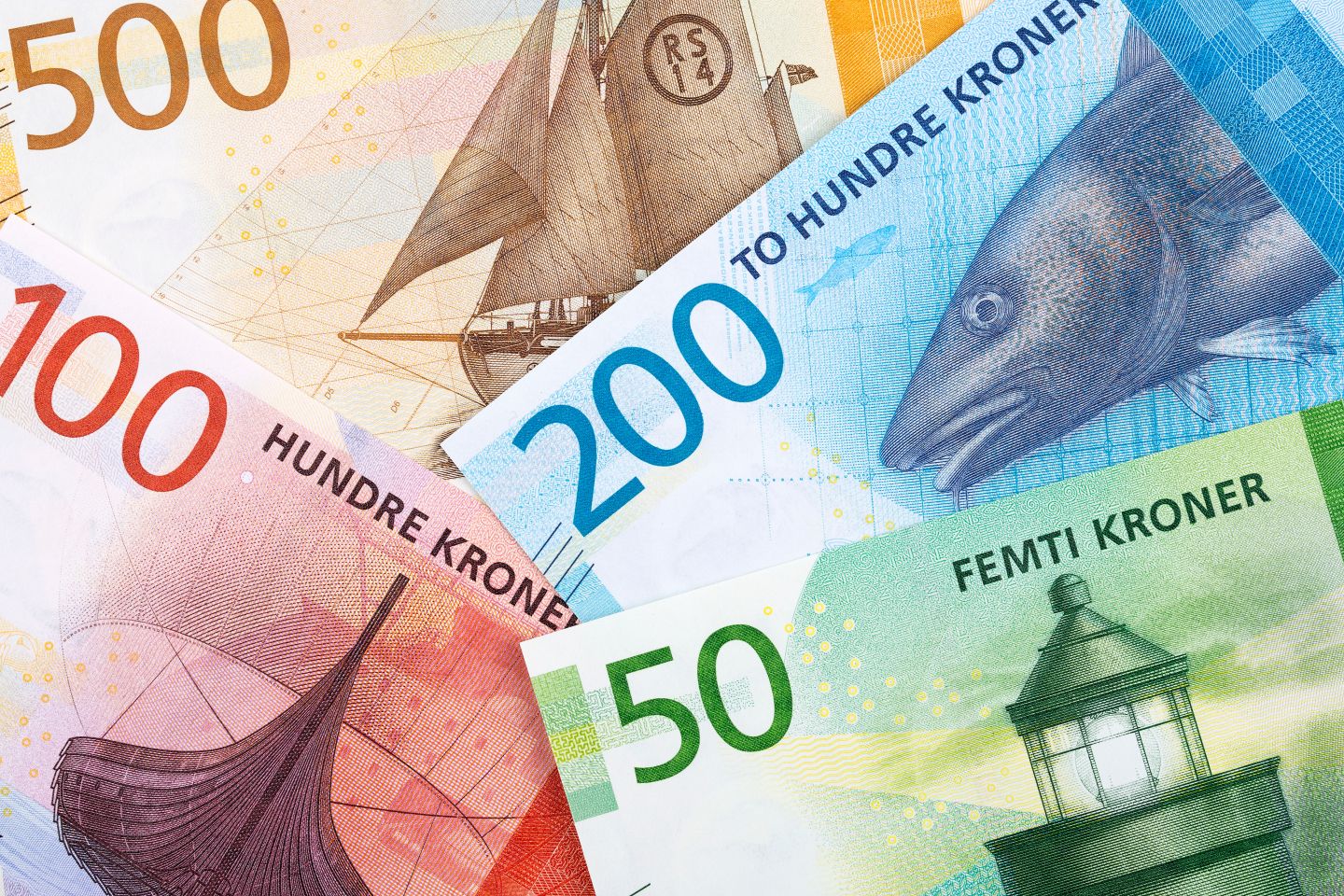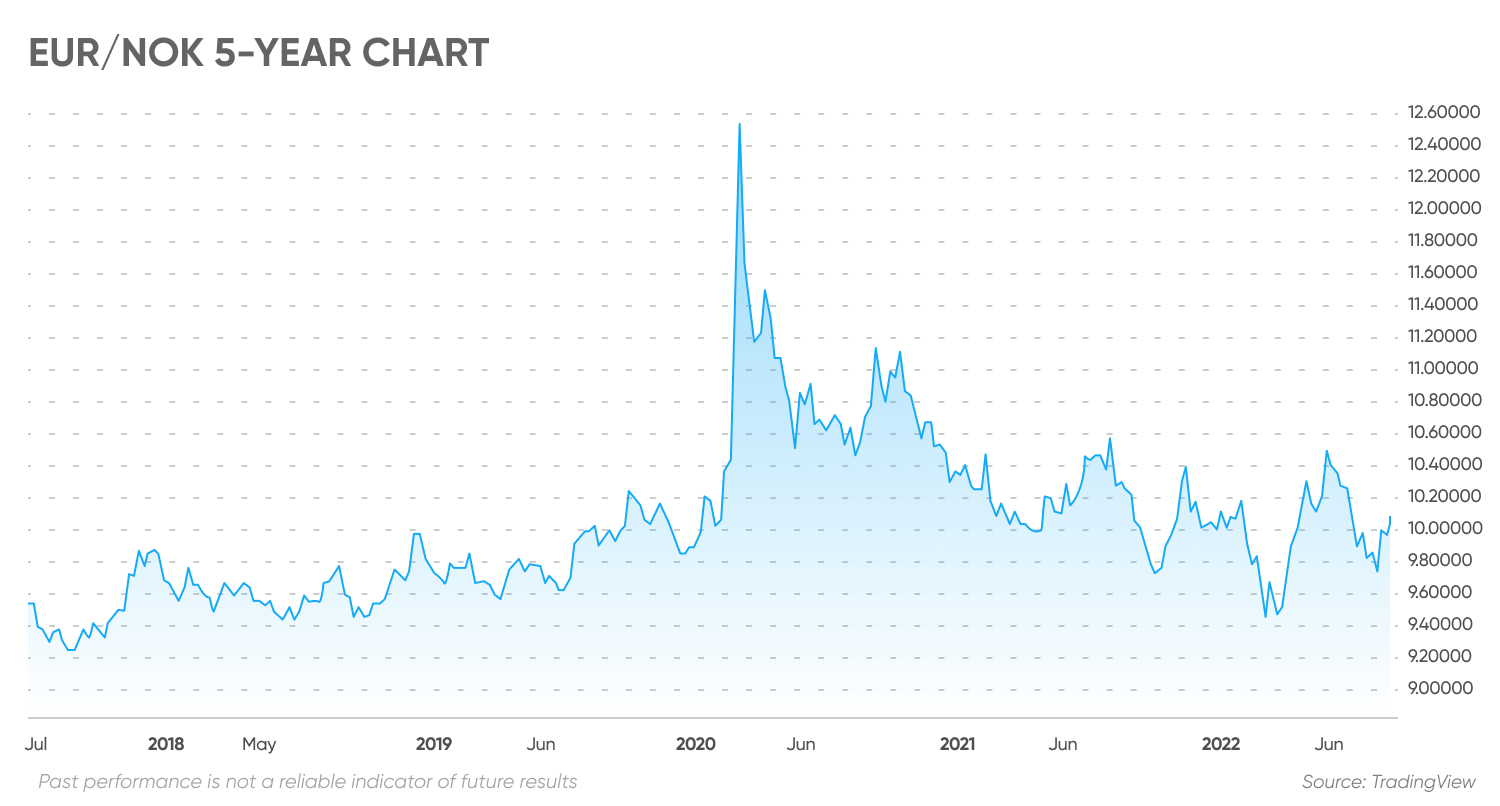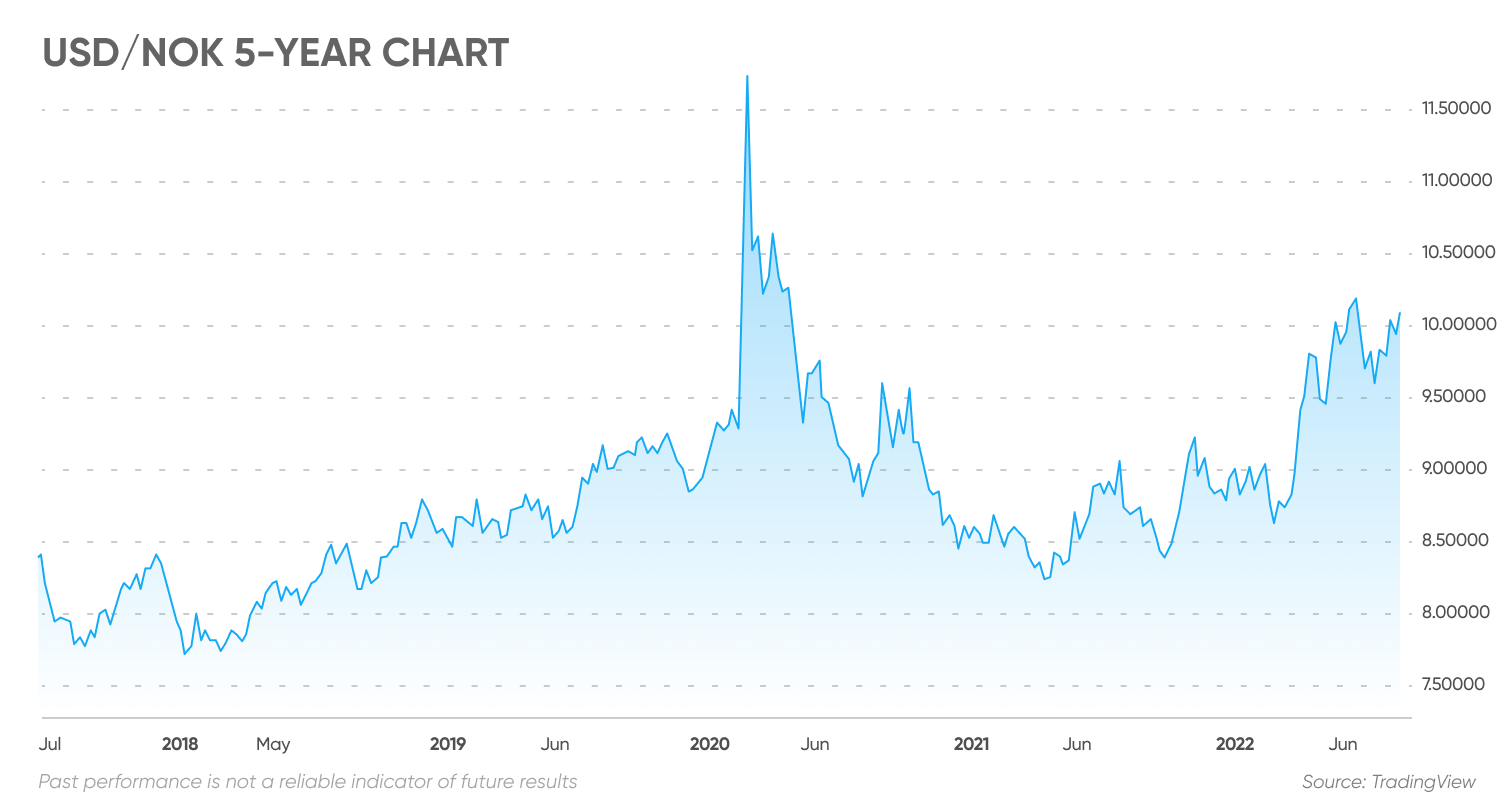Norwegian krone forecast: Energy-fuelled NOK keeping nose in front of EUR but still lags the dollar
The krone has recently weakened after enjoying a summer rally driven by high energy prices. What’s next for the currency?
The Norwegian krone (NOK) has weakened since late August after high energy prices drove a summer rally, as energy prices have retreated and Norway’s central bank Norges Bank announced an increase in NOK selling.
USD/NOK chart
What is the outlook for the krone? Will it continue to weaken or rebound?
In this article, we look at the currency’s recent performance and some of the latest analyst forecasts.
What drives the NOK?
As Norway is one of the world’s largest oil and gas producers, the Norwegian krone is considered to be a commodity currency, along with currencies such as the Australian dollar (AUD) and Canadian dollar (CAD). The value of the krone is affected by the direction of oil and gas prices, along with interest rate differentials to other countries and macroeconomic sentiment, particularly in Europe.
The sharp rise in oil and gas prices in Europe since the start of the Russia-Ukraine war has lifted the krone, with European natural gas prices reaching record highs in August.
NOK exchange rates have also been affected by strength in the US dollar, which is trading at 20-year highs, and volatility in the euro.
Energy crisis sets NOK direction
Norges Bank seeks stability in the value of the krone, and the currency has largely traded between 9-10 against the euro in recent years. The EUR/NOK exchange rate, which refers to how many krone are needed to buy one euro, spiked to 11.45 in March 2020 at the start of Covid-19 lockdowns. By the end of May 2020, the pair moved down to 10.50, then moved back up to 11.14 in September 2020 and was back above 11.10 in October 2020. But the pair began to decline to the 9-10 range, trading around 10.47 heading into 2021.

EUR/NOK traded down to 9.99 in May 2021 and reached its high for the year of 10.56 in August. The pair fell back to 9.73 in October 2021 and ended the year around the 10 level.
The EUR/NOK rate was trading at 10.19 in February before the Russian invasion of Ukraine resulted in strength in the krone and weakness in the euro, and the pair dropped to 9.46 on 25 March. The euro then strengthened against the NOK, and the pair rebounded to 10.36 on 18 May. The pair fell to 10.07 in early June before bouncing to 10.50 later in the month.
Soaring energy prices have since been supportive to the NOK and the EUR/NOK pair fell to 9.63 on 25 August on record high gas prices. But a subsequent retreat in spot energy prices and the prospect of the EU introducing an energy price cap pulled the NOK lower and the pair has returned to the 10 level in September.
In addition, Norges Bank announced on 31 August that it will increase its selling of NOK to buy foreign currency to NOK3.5 billion daily from NOK1.5 billion a day previously.
Despite strength in the NOK this year, the US dollar (USD) as a global safe haven asset has been stronger, rising to 10.17 against the krone in July from 8.82 at the start of the year. The USD/NOK pair moved down to 9.52 on 10 August, but has since returned to the 10 level.

What is the outlook for the NOK in the future?
Norwegian krone forecast: How will NOK perform against EUR and USD?
“The NOK recovered its losses over the summer due to higher energy prices and risk-on. Now the tide is about to turn and we see EURNOK trading above 10.00 in the months to come. Norges Bank will sell 3.5bn NOK/day going forward on behalf of the Government, due to a larger petroleum tax flow. At the same time, equity markets will likely continue to be choppy after the hawkish messages from central bankers, well-illustrated by Fed’s Kashari comment that he was “happy” with falling stocks. Both of these factors point towards a weaker NOK, while high energy prices should soften the blow. We see EURNOK around 10.30 by year-end,” according to analysis in Danish bank Nordea’s Norwegian krone forecast.
Analysts at Danske Bank also expect the NOK to weaken in their Norwegian krone forecast, predicting the EUR/NOK pair could rise to 10.40 by the end of the year and remain above 10 in six month’s time. Their USD/NOK forecast sees the pair trading up to 10.63 in six months.
But analysts at Dutch bank ING expect the Norwegian currency to strengthen in their NOK forecast and the EUR/NOK pair to trade down to 9.40 by the second quarter of 2023. “CAD and NOK weakness looks unlikely to last long in our view, as both currencies still have to fully benefit from the economic benefits of their positive terms of trade shock, which ultimately underpins sustained tightening by their local central banks,” the analysts wrote in their latest NOK prediction.
At the time of writing (14 September), the EUR/NOK forecast from Trading Economics indicates that the pair could trade at 10.04627 by the end of this quarter and at 10.32697 in one year, based on global macro model projections and analysts' expectations.
| EUR/NOK predictions | Q3 2022 | Q4 2022 | Q1 2023 | Q2 2023 | Q3 2023 | Q4 2023 | Q1 2024 | Q4 2024 |
| Commerzbank | 9.65 | 9.65 | 9.60 | 9.55 | 9.55 | |||
| Danske Bank | 10.00 | 10.40 | 10.20 | - | 9.80 | |||
| ING | 10.05 | 9.80 | 9.60 | 9.40 | 9.40 | 9.50 | 9.50 | 9.50 |
| Monex | 9.80 | 9.60 | 9.50 | - | 9.40 | |||
| SEB Group | 9.85 | 9.85 | 9.80 | 9.75 | 9.70 | |||
| Societe Generale | 9.80 | 9.70 | 9.60 | 9.50 |
Analysis from Trading Economics also expected the US dollar to strengthen against the krone, predicting that the USD/NOK pair could trade at 10.13 by the end of this quarter and 10.83 in 12 months’ time.
| USD/NOK predictions | Q3 2022 | Q4 2022 | Q1 2023 | Q2 2023 | Q3 2023 | Q4 2023 | Q1 2024 | Q4 2024 |
| CIBC | 9.90 | 9.75 | 9.44 | 9.24 | 8.97 | 8.80 | ||
| Danske Bank | 10.10 | 10.61 | 10.63 | - | 10.32 | |||
| Monex | 9.80 | 9.60 | 9.22 | - | 8.55 | |||
| SEB Group | 10.15 | 10.37 | 10.00 | 9.56 | 9.24 | |||
| Societe Generale | 10.10 | 9.70 | 9.32 | 8.88 |
The Norwegian krone forecast for 2022 from Wallet Investor at the time of writing (14 September) had the EUR/NOK pair trading from 9.979 at the start of October to 10.06 at the end of November and 1011 at the end of December, then trading down to 9.853 in September 2023 before returning to 10.00 at the end of next year. The algorithm-based forecaster’s Norwegian krone forecast for 2025 indicated the pair could then decline to 9.794.
Wallet Investor’s USD/NOK forecast estimated the pair could remain relatively stable over the coming years, trading at 10.07 by the end of 2022, 10.091 by the end of 2023 and 10.128 by the end of 2024. Analysts have yet to issue a Norwegian krone forecast for 2030.
When evaluating any Norwegian krone forecast, it’s important to remember that currency markets are highly volatile, making it difficult for analysts and algorithm-based forecasters to come up with accurate long-term predictions.
We recommend that you always do your own research. Look at the latest market trends, news, technical and fundamental analysis, and expert opinion before making any investment decision. Keep in mind that past performance is no guarantee of future returns. And never invest money you cannot afford to lose.
FAQs
Will the Norwegian krone get stronger in 2022?
The direction of the NOK could depend on energy prices, Norwegian government policy on interest rates and foreign currency reserves and the relative strength of the US dollar and euro, among other factors.
Will the Norwegian krone rise?
At the time of writing, analysts differed in their views on whether the NOK could rise against other currencies such as the EUR and USD. This emphasises the importance of doing your own research before making any investment decisions.
Is it a good time to buy Norwegian krone?
How you trade the USD/TRY pair is a personal decision depending on your risk tolerance and investing strategy. You should do your own research to take an informed view of the market.